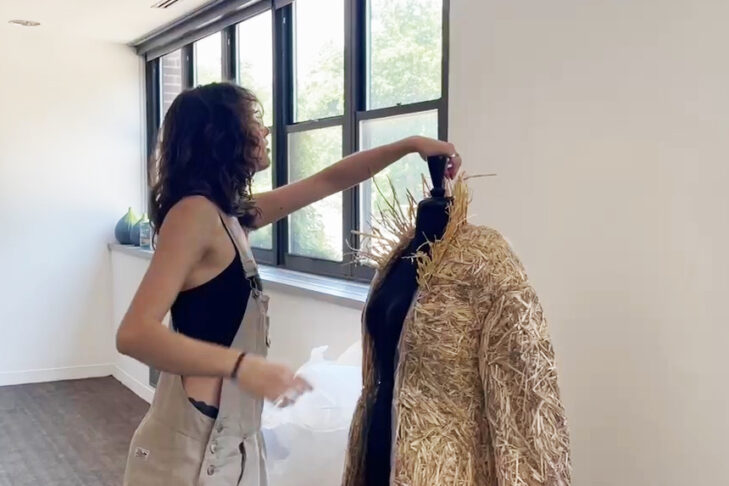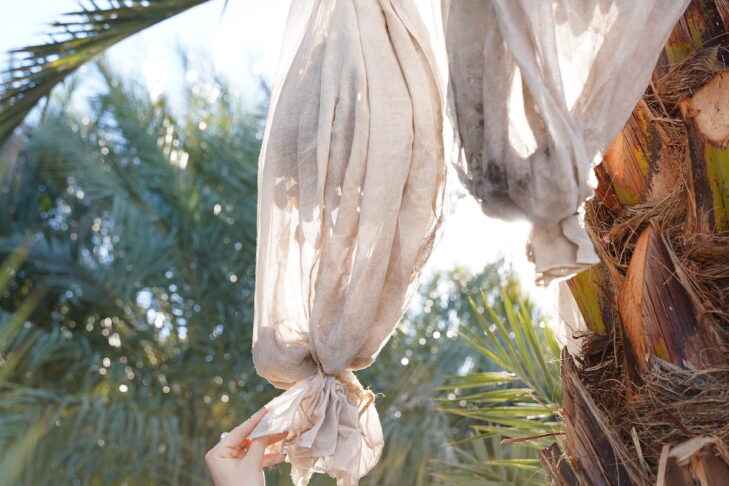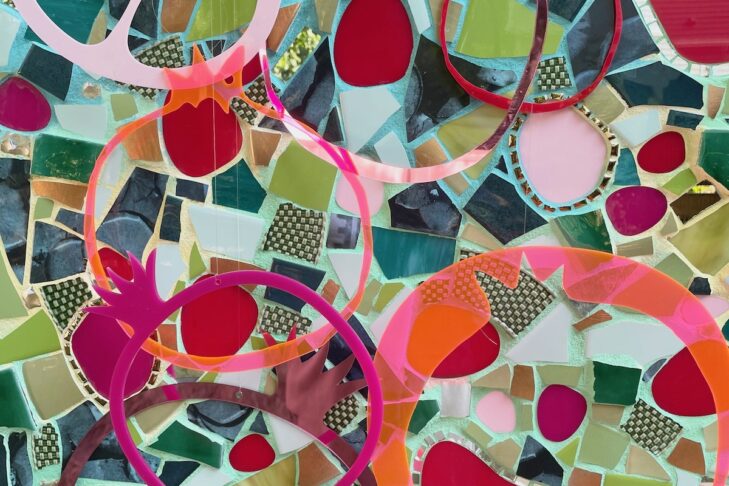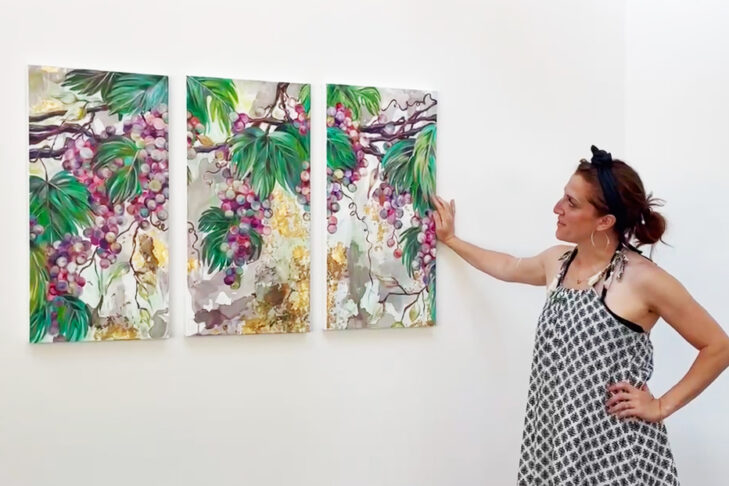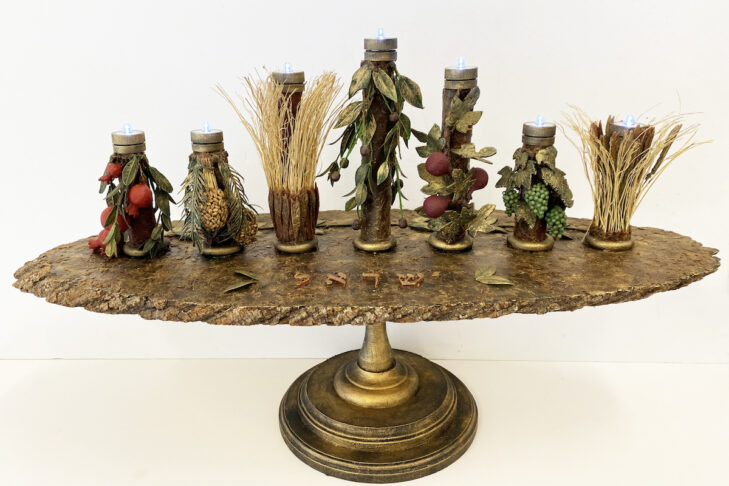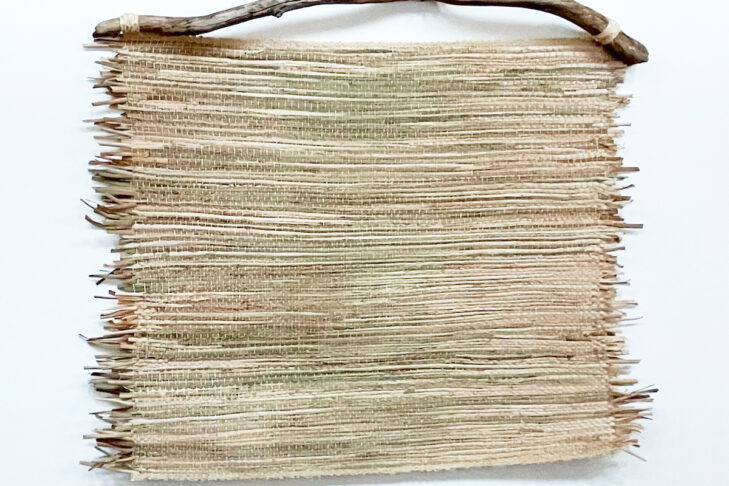In July 2021, mosaic artist Mia Schon and her cousin, Charlie Dov Schön Guterman, were thinking about mounting a family exhibition with a Judaic bent. It was obvious to Mia, who grew up in Newton and now lives in Israel, that Israel’s seven species as described in Deuteronomy 8:8—“a land of wheat, and barley, and vines, and fig trees and pomegranates; a land of olive oil and honey”—was laden with meaning for her family. Except for pomegranates, each food staple is indigenous to Israel and figures in Sukkot and Shavuot celebrations.
Mia and Charlie applied to CJP’s Arts and Culture Community Impact Grant Fund to underwrite their “Seven Species, Three Generations” exhibit. Sophie Krentzman, CJP’s director of arts and culture, told JewishBoston that the exhibition is an “intergenerational conversation.” She explained, “The project centers on the seven species and how the virtues of each plant or fruit embody the interconnected growth in their family of Jewish women artists.”
The Kniznick Gallery at Hadassah-Brandeis Institute and Women’s Studies Research Center at Brandeis University (HBI), where the women’s feminist interpretation of the seven species will be on display from July 29 through Sept. 15, is the perfect venue. Lisa Fishbayn Joffe, director of HBI, said in an email: “I’m so pleased to be hosting this show, which is rich with meaning, gorgeous and appealing to all the senses. The mission of HBI, and Jewish studies at Brandeis more broadly, is to produce and share new knowledge about Jewish life, traditions and texts. This show is a wonderful example of this, using the frameworks of gender, family relationships and art to find new meanings in these ritual foods and objects.”
On a recent morning, I met the Schön/Schon family (each woman uses a different spelling of her last name) over Zoom to learn about their art-making and the “Seven Species” exhibition, and to discuss their experience in working on a project together for the first time. As Mia shared the screen to bring up the seven pieces of art in the exhibition, she mentioned that she and Charlie randomly assigned the species to their relatives.
Ellen Schön, one of Nancy Schön’s daughters, applied her skills as a ceramicist to make her piece, “Family,” consisting of figs designed with open-source modeling software, then 3D printed and glazed and fired in an electric kiln. Ellen lives in Newton and teaches ceramics at Lesley University. Her novel approach to the assignment included using 3D-printed clay, which she explained “is an extruded paste or clay that is computer guided.” Ellen also noted the attribute associated with figs is perseverance. Schön’s figs are purplish-blue with swaths of light green. Seven larger figs are arranged around five smaller ones. “I interpreted the figs as a family,” she said. “In researching them, I learned they could be different colors, and I chose to do blue ones. I tried to make my version look sun-kissed. I’m also interested in fertility totems and figures, and figs, which are so plump and voluptuous, are reminiscent of pregnant figs.”
Charlie, the youngest of the family artists, is a recent college graduate who describes herself as a “found object, textile-based artist.” For her piece, “Harvest,” her species was wheat, which she pointed out means kindness. Charlie created a mid-length coat made of wheat that is encased in a tulle she quilted. The piece further reflects her double major in art and environmental studies in college. The coat brought together her expertise and inspired her to think of kindness as necessarily pairing action with words. “The presence of a body in the coat changes and stretches the definition of what this coat made of hay and wheat looks like,” she added.
Charlie’s mother, Susan Schön, is also a textile designer who has created art using silk and objects she has found in nature. Susan’s species was barley, and she simulated it for a wall hanging, “Barley Is Strength,” made of cattails and other natural things she found on her early morning runs in Andover. “I was interested in taking individual pieces that appear fragile and delicate but are really otherwise,” she noted. Susan eventually bought a 72-inch loom and wove a fabric that included the cattails and individual pieces of barley. Her fascination with birds’ nests came into play as she mimicked the way birds build their nests by weaving her new-fangled textile one piece at a time. She also included a particularly meaningful piece of driftwood into her piece that she found 25 years ago when the family was celebrating her late father’s birthday in Gloucester. “I had been holding on to that driftwood for a long time, and I found it was the perfect piece to attach to the wall hanging,” she said.
The three Schon sisters—Nancy’s granddaughters Jackie, Mia and Hannah—took on the challenge of interpreting fruits that included grapes, pomegranates and dates in a feminist light. Jackie said that painting grapes allowed her to experiment with color. “There are purple and green grapes,” she said. “Purple has different types of color and it’s a royal color. I wanted to include gold as well. It was liberating for me because I had not painted for a long time.”
Jackie founded and co-owns The Paint Bar in Newton and has taught painting and drawing there for 12 years. In “Gilded Grapes,” she depicted her rendition of grapes attached to intertwined vines, symbolizing how her family is bound together. She also deployed the number seven to paint seven bunches of grapes and paid homage to three generations of her family’s women artists by organizing her painting across three panels.
Mia, a mosaic artist, who has been commissioned over the years to create mosaics for synagogues, private homes and public art in Israel, incorporated the biology and Jewish symbolism of pomegranates in her mosaic, “I Followed the Pomegranate Seed.” For this piece, Mia experimented with laser-cut shapes of pomegranates made from acrylic mirrors to hang in front of her mosaic. As she worked on her piece, she kept in mind that in Jewish tradition, pomegranates are thought to have 613 seeds, a representation of the 613 mitzvot, or commandments, in the Torah. She also learned that pomegranate trees in proximity to each other reproduce more quickly. “They populate depending on how close they are, and I felt that is how our family is and how art developed for us,” she said. “The more artists there are, the more artists we’ll have so that a fourth generation continues this tradition.”
Hannah, the youngest Schon sister, is the only non-visual artist in the group. A dancer, photographer and filmmaker based in Austin, Texas, she took a different route. “In researching my documentary, I discovered that Coachella Valley in California is the largest North American exporter of dates,” she said. Hannah met Sam Cobb, the only Black date farmer, or, as he calls himself, an agricultural engineer, in the country. “The film is documentary storytelling meets dance,” she explained. “Making the documentary was eye-opening, enabling me to see food through a different lens and how I incorporate dance and movement into that. My project has become an amalgamation of everything happening in my art-making. And I discovered dates grow in seven-year cycles in stages of three. Those are important numbers in Sam’s farming practice.” Hannah’s video installation, “The Deglet Noor,” is named for the dates Cobb grows. The video will be shown in a corner of the Kniznick Gallery draped in muslin. The intention is to transport viewers to a natural environment Hannah has reimagined, an earthbound environment “flushed with colors sourced from the vast sky of Joshua Tree and the date grove.”
Nancy, known for her sculptures that include the iconic “Make Way for Ducklings” in Boston Public Garden, jokes that she is the matriarch of this endearing clan of women artists. To that end, she describes her evocative piece, “Generational Unity,” “as a summary of the seven species with a focus on olives. Olives are symbolic of Israel, so it seemed natural to do a sculpture of a menorah referring to the seven of us.” Nancy’s sculpture brings together versions of the seven species that her daughters and granddaughters imagined and brought to life. Among the mixed media in Nancy’s sculpture are broom whisks representing barley and handmade pieces of grapes and dates made from plastic, clay and paper. Additionally, Nancy integrates real pomegranates into the piece, and although her representation of olives and figs are made of wax, her creations hew closely to the real things. “You see that I have embraced the entire menorah with olive branches as though my arms are around all my family,” she said. “That image represents my story.”
“Seven Species, Three Generations” will open with a reception on Thursday, July 28, at 5 p.m. The exhibit will be on display at the Kniznick Gallery at Hadassah-Brandeis Institute and Women’s Studies Research Center at Brandeis University through Sept. 15.


